Examine the Role of Urban Management in the Development of Small Towns (Case Study: Bandare Torkeman City)
Ali Akbar NajafiKani1 and Zahra Mohammadi2 *
DOI: http://dx.doi.org/10.12944/CWE.10.Special-Issue1.10
In terms of the urban development discussion with grassroots participation, if applicable, the idea and the realization of the continuity and will be based on a codified policies and planned initiatives and work devices and headquarters of organs and institutions involved in the development, transformation and urban management in this regard, the municipal Manager is a function of the set of factors and host components. So on the subject of urban management and development program formulated and set of policies, practices and responsibilities of the main administrative, municipal notice has to be confidence - building, with the culture and people's participation in the cooperative activities of the municipality, to prepare and mobilize; otherwise in terms of complexity and, with regard to the dimensions of the problems today in the science of management and enabling the accumulation of people's demands and limited, especially in the areas of the municipalities of theoretical and achieve development, Advisory And a successful and constructive management without the use of massive capacity will be popular, low yields and the main objective will not be achieved and strategic. It is obvious that determines and identifies areas of citizens ' participation in Urban Affairs and services has long been part of the urban management authorities and concerns was and is. In this issue there is that the interactive triangle between citizens and municipal authorities, professionals involved is not well formed. This is the basis,the aim of this study was to examine the relationship between urban development policies, urban management system. Research papers, survey strategy is based on the cross. Data were collected through a questionnaire among 250 residents of Bandare Torkeman and the chi-square test and Kruskal-Wallis one-way analysis is located. between the people and the situation in the sense of participation among citizens as well as the crystallization of lead.
Copy the following to cite this article:
NajafiKani A. K, Mohammadi Z. Examine the Role of Urban Management in the Development of Small Towns (Case Study: Bandare Torkeman City). Special Issue of Curr World Environ 2015;10(Special Issue May 2015). DOI:http://dx.doi.org/10.12944/CWE.10.Special-Issue1.10
Copy the following to cite this URL:
NajafiKani A. K, Mohammadi Z. Examine the Role of Urban Management in the Development of Small Towns (Case Study: Bandare Torkeman City). Special Issue of Curr World Environ 2015;10(Special Issue May 2015). Available from: http://www.cwejournal.org/?p=105
Download article (pdf) Citation Manager Publish History
Select type of program for download
| Endnote EndNote format (Mac & Win) | |
| Reference Manager Ris format (Win only) | |
| Procite Ris format (Win only) | |
| Medlars Format | |
| RefWorks Format RefWorks format (Mac & Win) | |
| BibTex Format BibTex format (Mac & Win) |
Article Publishing History
| Received: | 2014-11-19 |
|---|---|
| Accepted: | 2014-11-24 |
Introduction
one of important matter that swayed economy and social condition in recent ages is the appearance of different cities, new towns, development of old cities, growth of inhabitants in town and finally city development for reaching to city development, city administer is the important tool. City extension that made from organization of factors, forces and resource for manage the affairs and answer to citizens needs and include: consequence of plan, perform, oversee and control; city administer with organization and formation the city, preparation and manage the exploitation from attraction, improvement and repairing the historical remains (places), extension of green spaces and parks and perform the plans of city development, plag the most important role in development of cities (Fanni and et al, 2005). Whereas in present condition sound that city administer system face with challeng about using of people helps in city management. On this base , present research focus to survey the role of politics of city administer systems and people helps on city management.
Theorical Elements of Research
Administer and City Development
The city is complex of human, physical, social and economical activities, on this base it's necessary to better use of complex activities and prevent from waste of management forces by use of last found ations about the best ways of behave with human, environment and economy resources take place (Werna, 1995). That role of city administer is very important in ways of city development and improvement of city inhabits. From other standpoint, we can take city management into account in way of a lawful and steady development. This matter have more importance, because the way of management on desirable current of city life con plag most important role in improvement of human inhabits and stability of city development (Shieh, 2003). The greatest duties of city administer (tow halls and city councils) in supervising of cities, is preparation the basic under constructions for streamlined actions of cities, preparation the needed service for development of human resources, improvement the usage and standards for citizens life, setting the activities of privacy part that effective on safety, health and social comfort of citizens and … (Hoseini et al, 2012).
The process of city development is affected by economic al, environmental , social, political and population reasons that has been passed different stages along history (times). city development when will be steady that along times, it's be a city that in terms of environment be able to inhabit and live (clean air, healthy water, fields, shallow and underground waters without dirt and pollution), in terms of economic be durable (city economy must can adaptable with technical and industrial changes for conservation the basic jobs and reasonable house and supply their inhabits with equity tax) and in terms of social be unity (practical models of fields, social unity and citizen feelings), that human can gain justness income, supply house and dedicate their efforts and times for protection of city.
The Methodology of Research
The happening of this research is description analytic and base on ways of pathing. The tool of evaluation in this research is question sheet. The all citizens of Bandare Torkeman town with 48736 person, make the statistical society of this present research. Take sample from society is done by systematic accidently and with use of kokran formula that on this base 244 person choose as members of sample bulk that 250 personchoosed as final sample for increasing the quality and credit of more correctness.
Particulars of Limits of Study Matter (case)
Bandare Torkeman is one of west towns of golestan - province the geographical location of this town is in the range of temperatures between east length, 54 degree and 6 minute from the grinvich meridian and north wideness (parallel) 36 degree and 49 minute from equator and situated at a side of Tehran - gorgan connection path (road) (The city of Bandare Torkeman conductor, 1999).in terms of relative location, this town is a center of Torkeman City that situated at south-east coast of Caspian see and the side of gorgan gulf and round about 35 kilometers have distance with the gorgan (center of province). the elevation of town from the level of Caspian sea is almost 6/5 meter higher . the limits of Torkeman town from north is gomishan town and from east is aqqala town and from south – east is gorgan town and from south is kordkoy town and from south – west is Bandare Gaz town and from west is gorgan gulf and Caspian sea. The population of this town was being in accord to statistics of the years 1956,1966,1976,1986,1996,2006 and 2011 in orderequal with 8284, 13081, 17339, 28358, 38782, 45249 and 48736 person (the statistics center of iran, 2013).
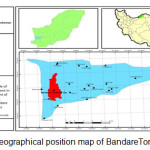 |
|
Research Foundations
Description Foundations
The results that gained from question sheet show that the most number of persons that answer, with 92 profusion is related to age group 31 to 40 and a little of then with 18 profusion related to age to the group less them 30 yours old and more them 60 yours old. 73/2% of persons were man and 26/8% of then were woman, also 86/8% are married and 13/2% are single. place of birth of 85/2% of persons is in town and 14/8% of them is out of town. is relation to level of education, most of them with 87 (profusion), concern to b.c (expert) group and a little persons with 6 profusion concern to m.s (master) group and higher level, also demanding for continue the life between this persons is in average level.
Perception Foundation
In this part and in relation to topic of research, 2 matters will pose: the politics of city administer system and development of city space that is this direction the factors: ''the reaction of managers'', ''civil projects and city services'' and ''the situation of usage of city fields'' in relation to politics of city administer service and the factor ''access to city possibilities and a barriers of city development'' about entrance of city space will be study.
*The reaction of authorities (principal) :The elevation of reaction is one of the basic and main tools of administer for searching to goals, strategies and plans of organizations. in public organizations like town hall (public office of city), the design and establishment of evaluation system can lead to right guidance of executive principals for reaching to goals, duties, ways and development plans and improve the city services coincide with quality. Expenses and time. as town hall is responsible for administer of city as public organization, its necessary to evaluate the action and ultimately manage the action (Memarzadeh et al, 2009). on this base and in relation to the level of satisfaction of citizens from the principals reaction in field of city development, the information at Figure (2) available and attention to marked average show that level of satisfaction of citizens toward the principals is not satisfactory.
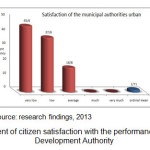 |
|
*Civil Projects and City Services
For survey of relationship between satisfaction level of town hall action and presenter systems of city services, from 10 factor has been used.
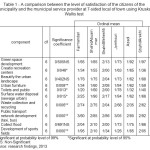 |
|
*Situation of Land Usage of City
one of important point in fields of city administer is related to use of field manage based on city development plans. Field is main element in city development because of this control of ways of using it and count the real need of city to field for supply different usage at present time and conformity of digits (numbers) and gained quantities to future at solve the problems of field, house and suitable growth of cities accord to city development plan is effective (Khakpour et al, 2007).
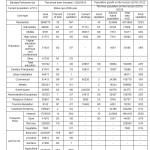 |
|
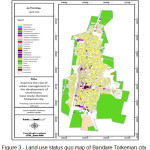 |
|
With attention to extant information at comprehensive design and doing the digit counting (evaluation of extant lack and future need accord to good capitation) and based on sounding that done, also around observations and extant matters and examples, Bandare Torkeman town in educational usage (elementary, middle and high school), sanitary - therapeutic, commercial, green space (parks), administrative - disciplinary, religious – cultural and also tourism - reception, didn't have the desirable and acceptable growth and development. Certainly, in form of partly and nominal, is some parts like educational usage, sanitary - therapeutic, commercial, administrative - disciplinary and religious - cultural, we can see evidences and signs of growth and boom that again it's not proportionate with increasing of population, physical growth of town and variety of needs and cumulative immigration of village to town especially because of attraction of maskanemehr apartments. In another usage that mentioned at first, mainly. In green space (parks) and tourism- reception, have been felt a lot of weakness and lack, inspire of their basic and important impression on space and appearance of city and create mobility in more scopes. The compact and increase of population breath and also the needs of town community and young generation and the rate of times changes, cause to have preparation and storage in this fields with knowledge and programs and huge management.
*Access to Town Possibilities and Under Constructions
The equal and approached distribution of different possibilities and services is the way for shift the unbalanced regional and raise the level of people life (Ghanbari, 2012). the gained results show that the satisfaction of citizens toward the existence of elementary middle and high schools in their vicinity with (2/81) average and existence of university with (2/51) average is in relative level, in spite of other factor that satisfaction in them accord to lower average from average level is in lower level.
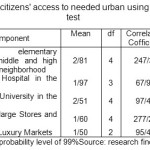 |
|
*Barriers of City Development
For comparison the citizens ideas about the challenges of city development in political and social - cultural parts at 7-sided local of town is used from Kruskal-Wallis nonparametric test (table 4). as its ob served in table (4), in political part , the difference between inattentiveness on behalf of principals and planners especially the un native principals and enough inattentiveness of showground principals to 99% and in another 2 factors, un specialty of many town authorities and principals and allocation of especial reliable rows for coast development to 95% is meaningful.
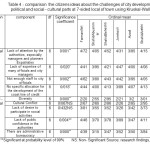 |
|
In social - cultural part there factors in order of priority known as main barriers of city development the mistrust to principals, existence of official dies orders and variety of nations. firstly the people known the barriers of city development with care and sharpness and secondly with use of suitable and seasoned principals try to reaching to purposes and constructive planes. and from this easy, we can easiness the difficulty of official system with fingertip of strategy thinking and specialty and commitment in course of the satis faction of people and if this purposes be produced the variety of nation in steed of being barrier, can be useful and change to great bed for discover the talents and use of capacities and improve of social and national reinforcement.
Conclusion
On the one hand, and the development and transformation of the problems and needs and legitimate demands of citizens associated, requires that the sides and aspects of civil society and citizens, relevance and transparency and continuous communication is established which is the case for sustainable development; responsible to the people of the area feel strongly committed to their task, and to answer their concerns and citizens interact are mutually aware of such officials, to transfer useful information and strategies and design requirements and are sympathetic criticism. The evolution and growing scientific and realistic, certainly leads to such empathy and collaboration, resulting in the discovery of hidden talents and assets of the lost and be. In this process, God is the audience and the people, service and honesty, creativity and development and the sustainable development based on social justice, ideals and dreams of all. On this base, the ideas offer in order to improvement of city development for suitable use of existence capacities, the most important of them are blow:
- Development of green space in from of local parks for simplification of people access and the increase of its budget with considering the people and the existence lack;
- The development of public transporting in from concentrate terminals for traveller for best control and management and erection of freeway for decreasing the traffic of city and increase of usage transportation;
- The erection of repel sewage channels and prevent from evacuation of home sewage into sea to prevent from environment pollution;
- Upgrade the level of public information with set up co-working culture and permanent consult between principals and people;
- Making organization and syndicates and organize them in field of co-working in civil designs and projects;
- Design the sounding cites and electronic link between people and townhall;
- Consult with citizens in programs and decisions and making use of the experiment and specialty of citizens in accord to their desires to way of supervising co-working and advisory in sounding.
References
- Dawn of Consulting Engineers, The city of BandareTorkeman conductor (1999).
- Z; and Mohammad Nejad. A. The Role of Urban Management in Tourism Development (Case Study: Ramsar city), Tourism Studies, (11), 101-122 (2005).
- Ghanbari, M. Analysis and evaluation of municipal services to the city of Isfahan, according to indexes using Morris. The fourth National Student Conference of Geography and Urban Planning. May 8, Tehran (2012).
- Hoseini, S.M. And Ashorlo, M. Comparative study of urban management in the world. The fourth National Student Conference of Geography and Urban Planning. May 8, Tehran (2012).
- Khakpour, B.A; Velayati, S.A. And KiyaNejad, Gh. The pattern of land use change in Babylon for 62 - 78 years. Geography and Regional Development, (9), 45-64 (2007).
- Memarzadeh, Gh.R. And Tabrizi, P. Evaluation of the performance of the proposed model for the performance evaluation of Tehran. Management and Urban Planning. (3), 41 (2009).
- Shieh, E. The need for change in urban management. Geography and Development. (1), 37-62 (2003).
- Werna, E. The management of urban development or the development of urban development? Problems and premises of an elusive concept. Cities, (5), 353-359 (1995).







